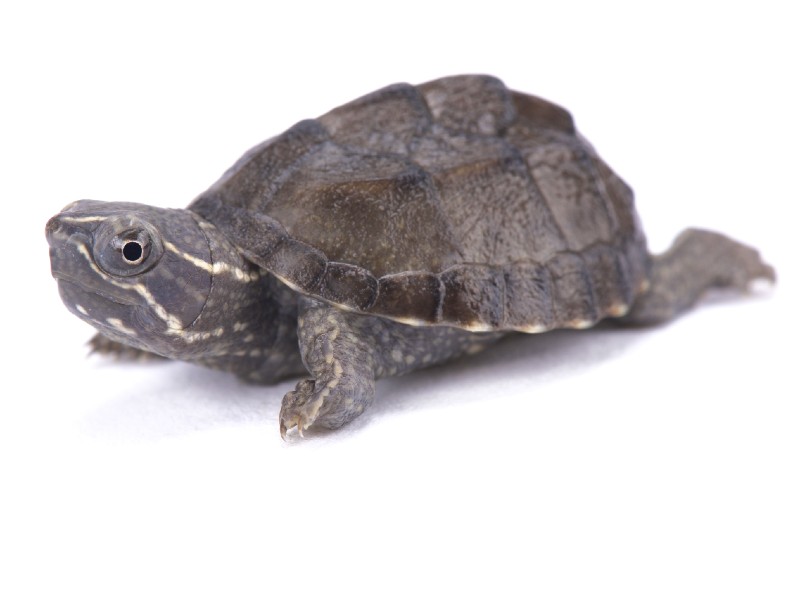
Turtles are fascinating creatures that are fairly easy to care for and can make great pets. In particular, Common Musk Turtles are a frequent choice among turtle enthusiasts because of their small size and relatively low demands for care.
Whether you are thinking about getting a Common Musk Turtle or already own one, it is essential to know how to care for this creature. Keep reading for a comprehensive care guide for Common Musk Turtles, as well as some fun facts about these amazing reptiles.
In recent years, Common Musk Turtles have become a popular choice among turtle owners. Though these turtles may be small, they are complex creatures with specific care needs. The following guide will provide you with more information on Common Musk Turtles and inform you how to care for them.
Common Musk Turtle Overview
Common Musk Turtles are a species of turtle native to the Eastern United States and Southeastern Canada. These turtles are commonly found in the wild in these areas. Additionally, they are frequently bred in captivity as their popularity has risen as pets.
Common Musk Turtles are small, ranging in size from 2-5 inches across their shell. Their most distinctive marking is the bright yellow lines that run down both sides of their neck. These turtles weigh less than a pound at birth and do not exceed 3 pounds.
Common Musk turtles thrive in environments near freshwater sources, including ponds and lakes. They are frequently found in mud and reeds near these areas and are seen swimming in waters or sunning on logs.
Although it is a commonly found turtle, its species has seen a recent decline due to environmental destruction in some areas. In certain parts of Canada and states such as Iowa, its status has been changed to threatened to reflect the declining populations.
Care Guide
Owning a Common Musk Turtle will require preparation and responsibility on your part. When you own a Common Musk Turtle, please take into account the following factors to make sure your turtle is happy and healthy.
Habitat
Your turtle will need a contained space to live in that meets its habitat needs. Common Musk Turtles will need a tank that can hold both a source of water for them to swim in and dry areas where they can rest.
It is recommended to keep the tank water shallow enough so that your turtle can reach the bottom without having to paddle.
At a minimum, you should purchase a 30-gallon aquarium for your Common Musk Turtle, increasing the size accordingly if you have more than one turtle. For two turtles, a 40-gallon aquarium is recommended. Your turtle will enjoy the space as he or she goes about their active daily routine of swimming.
Even though they do not come out of the water for long periods, you will still want to provide areas where they can dry off and bask in the light. This does not have to be an extensive land feature and can be as simple as a floating dock or log where they can climb out of the water.
The tank water should be filtered and non-chlorinated. It is essential to have a filter on your tank that will keep the water clean and free of chemicals without harming your turtle. Please make sure the filter is compatible with shallow waters to make sure your tank is at an optimal level of cleanliness.
Heat and Light
All turtles require certain specifications for heat and exposure to light, and the Common Musk Turtle is no exception.
Common Musk Turtles should have a consistent water temperature at around 80 degrees Fahrenheit. In their basking location, install an aquarium-safe light that will heat their dry area to around 90 degrees Fahrenheit. Please make sure the water heater is always submerged to avoid overheating or electrical shock.
Common Musk Turtles also require UV light exposure to properly metabolize vitamins and stay healthy. Many pet and reptile stores sell UVB bulb lights that are specifically designed for aquarium use. Install one of these, and keep it on for 12 hours each day to make sure your turtle stays healthy.
Diet and Feeding
Common Musk Turtles will require a specialized diet to make sure they are properly nourished. In the wild, this species of turtle most often eats the following things:
- Small fish
- Tadpoles
- Algae or duckweed
- Small insects such as dragonfly nymphs
However, these items may be difficult to access for your pet Common Musk Turtle. Instead, many pet owners choose to feed their Common Musk Turtles a combination of the following:
- Cut fish
- Earthworms
- Crickets
- Pelletized turtle food sold in pet stores
Consider experimenting with some different foods to find what your turtle likes best. Just be sure to check that it is something your Common Musk Turtle can safely eat.
You should feed your Common Musk Turtle around once daily if it is young and then switch to every other day as turtles become older. Some people choose to feed their turtles as much as they can eat in one sitting, and others feed them for about 15-20 minutes per feeding session.
Lifespan and Health Concerns
Purchasing a Common Musk Turtle is a long-term investment. These pets can live up to 50 years in captivity and sometimes even longer if properly cared for. It is most common for these turtles to live anywhere between 30-50 years.
Some of the most frequent health problems that afflict Common Musk Turtles include:
- Parasites
- Infections and diseases
- Deficiencies in vitamins, such as Vitamin A
If you notice that your turtle is exhibiting strange behaviors such a respiratory issues, diarrhea, weight loss, or lethargy, your turtle may be sick and should be taken to a veterinarian for examination and diagnosis.
If you suspect that your turtle has a vitamin deficiency, it may be worthwhile to add a vitamin supplement to their diet that is approved for reptile consumption.
One other common health problem that could affect your Common Musk Turtle is obesity. If your turtle is bulging out of its shell, he or she is overweight. When this happens, you should cut back on the amount that you feed your turtle until a healthy weight is reached once more.
Behavior
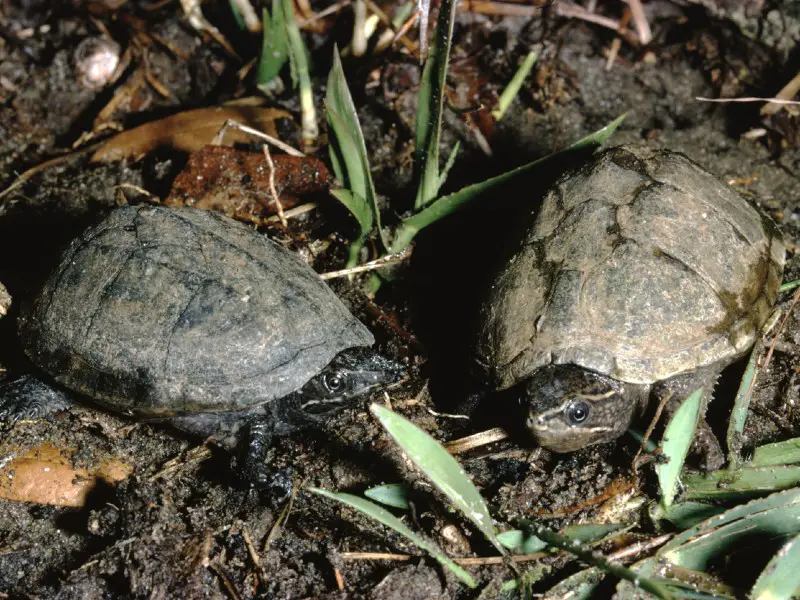
Common Musk Turtles are spirited little creatures. Although they can be fun to watch, they are generally not too friendly towards humans, and you should avoid handling them roughly or excessively, or they may bite you.
Additionally, when a Common Musk Turtle feels threatened, it will release a sharp odor that famously gave them its name and its common nickname of ‘Stinkpot.’ To avoid this smell, do not harass or overhandle your turtle.
Most Common Musk Turtles males do not get along and will exhibit aggressive behavior toward one another. For this reason, you should not keep two males together. If you keep a male and female together, you may need to occasionally separate them as the male can disturb the female.
For first-time Common Musk Turtle owners, it is best to start with just one turtle or keep only females together to avoid behavioral issues.
How to Keep the Common Musk Turtle Safe
Common Musk Turtles are best kept safe by closely following their habitat and diet needs. If your turtle is well-fed, has all its vitamins, and receives enough sunlight and warm water to swim in, it will be much easier to keep him or her healthy than if you neglect any of these aspects.
You can also keep your Common Musk Turtle safe by making sure it is always swimming in clean, fresh water and is not interacting with an exposed heater or electrical wire.
Another way to keep your Common Musk Turtle safe is ensuring that your turtles are captive-born and are not interacting with turtles you bring in from the wild or other species. This can lead to dangerous infections between wild and captive-born turtles, and different species may fight or harm one another.
Does the Common Musk Turtle Pose a Threat to Humans?
Common Musk Turtles are not poisonous and generally will not harm humans. However, they may bite you when you handle them, which can be unpleasant. To avoid this, you should handle your turtle by holding it toward the end of its shell and avoid putting your fingers or hands near its face.
Additionally, though Common Musk Turtles are not poisonous, they could carry bacteria or other substances you would not want to ingest. Whenever you handle your turtle, you should wash your hands immediately afterward and avoid touching your face or handling food until they are clean.
Average Cost and Where to Buy a Common Musk Turtle
Common Musk Turtles are budget-friendly pets, and in general, they cost anywhere between $20-$70. When you purchase a Common Musk Turtle, you should also budget for the money you will need to spend on their housing and care.
Aquariums and heating apparatuses can be more expensive than the turtle, and they are essential to keeping your turtle happy and safe. You will also need to regularly purchase food and have money on hand to take them to the vet if your turtle ever gets sick.
You can buy a Common Musk Turtle from most pet stores or specialized reptile stores. You may also choose to buy them online from certified reptile dealers. If you do buy a turtle online, ensure that the seller is legitimate and meets all health and safety standards.
You should avoid capturing a Common Musk Turtle in the wild and bringing it into your home as a pet. Not only is this a great shock to the animal, but it could also lead to the release of invasive species or parasites in your aquarium that could infect other turtles, animals, or plant life.
When you purchase a Common Musk Turtle, it is best to make sure that it is captive-bred and that you are not contributing to ecological harm by bringing in a wild turtle.
Common Musk Turtles Facts and Useful Information
|
Species Facts |
|
|
Common Name |
Musk Turtle |
|
Species Name |
Sternotherus odoratus |
|
Family Name |
Kinosternidae |
|
Price |
Between $20-$70 |
|
Size |
Three to five inches long |
|
Lifespan |
40 to 60 years |
|
Diet |
Seeds, insects, snails, tadpoles, algae |
|
Tank Size |
Minimum of 20 to 29-gallon tank |
|
Humidity and Temperature |
Water tank with a temperature between 72°F to 78°F |
|
Popular Alternatives |
Razorback musk turtles |
Common Musk Turtles are fascinating creatures. The following are some fun facts about your Common Musk Turtle:
- Common Musk Turtles lay between 1-9 eggs each breeding season.
- Common Musk Turtles are mostly carnivorous but sometimes eat aquatic plants like algae.
- Despite being aquatic, Common Musk Turtles are not very strong swimmers. They prefer to walk along the bottom of lakes or ponds rather than continuously swim.
- Common Musk Turtles are also known as Stinkpots due to their odor.
Because they prefer to walk, you should always make sure your Common Musk turtle can touch the bottom of the water in their tank. Make sure they have enough water to stand on their toes and have their nose above water.
Additionally, even though they are omnivorous and sometimes eat plants, your Common Musk Turtle probably will not be too interested in any vegetables or fruit you may try to feed him or her. Stick to meat-based food to start, and avoid feeding them anything without first checking with your veterinarian or an expert.
Summary
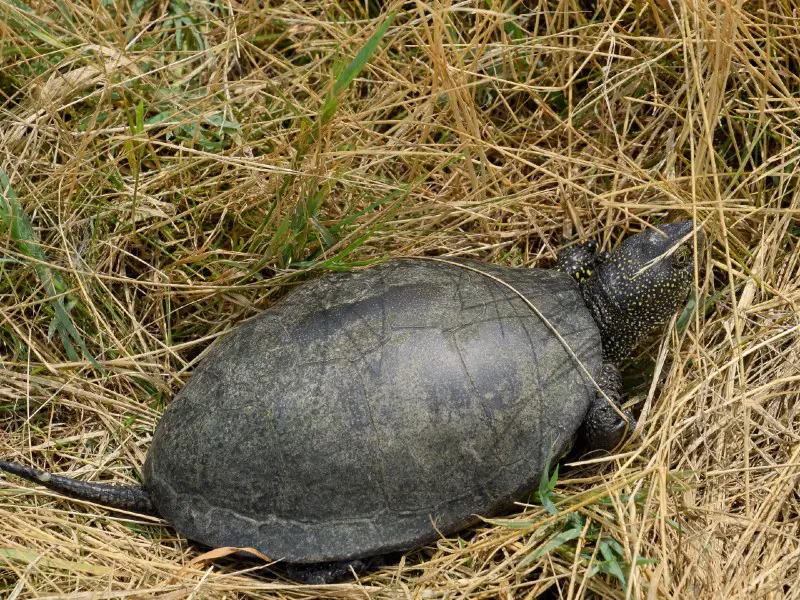
Common Musk Turtles are small in size and fun to watch as they go about their lively swimming. For this reason, many reptile enthusiasts have chosen this turtle species as their pet of choice. If you are choosing to buy a Common Musk Turtle, you will be adopting a pet that is easy to care for and fascinating to observe.
However, when you buy a Common Musk Turtle, you will need to ensure that you can properly care for him and her. Make sure you can provide them with a safe and comfortable habitat, as well as all the dietary needs that they may require. If you suspect your turtle is not fully healthy, seek veterinary care.
The popularity of these small turtles has made them widely available at pet and reptile stores. If your heart is set on one of these fun companions, you will soon be able to find a Common Musk Turtle for you.
References:

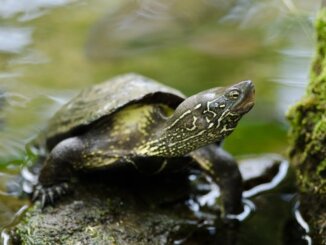
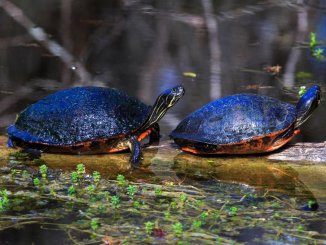
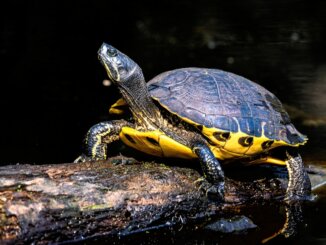

Hi Mr David, my daughter has two musk turtles that are about 2 years old. I bought the tank from the place where I bought the turtles and I do not think it is suitable.It is called a Love Fish panorama 64 litre tank which I think they have out grown. I would like to purchase a bigger tank say, 40 inches long. It is also not heated which I was told was not necessary but I’m not sure if that’s true as they become less active in the winter. I live in the Uk but there appears to be no places to buy a large tank. I would be happy to ship one over from the US if you could advise me where to purchase one.
Your tank is small for two musk turtles.
Recommended size would be around 160-180 liters, so almost twice as much. It seems unlikely that you won’t be able to find one in the UK, although you might want to contact specialized shops (specialized pet shops might have what you need too).
Less activity in the winter is normal, and they can even go into brumation (a hybernation-type state). However, considering you live in the UK, you might have to heat the dry part of your enclosure up to 32°C. Significantly lower temperatures for long periods of time won’t be ideal for your turtles.